Welcome to our comprehensive guide on how to use a portable tire inflator. Whether you’re a beginner or looking to improve your skills, this step-by-step guide will walk you through the process of efficiently inflating your tires. With our helpful tips and instructions, you can master the basics and ensure safe and comfortable rides on the roads of Kenya.
Key Takeaways:
- Proper tire inflation is crucial for a safe and comfortable ride.
- Check your tire pressure regularly to maintain optimal performance.
- Choose the right air pump for your portable tire inflator.
- Follow the recommended tire pressure values for your vehicle.
- Maintain your tire pressure for better fuel efficiency and tire longevity.
Importance of Proper Tire Inflation
Proper tire inflation is crucial for a safe and comfortable ride. Maintaining the correct tire pressure ensures optimal tire performance and extends the lifespan of your tires. In addition to safety, proper inflation also has a significant impact on fuel efficiency and handling.
When tires are underinflated, they create more rolling resistance, which causes the engine to work harder and consume more fuel. This can result in decreased fuel efficiency and higher fuel costs over time. On the other hand, overinflated tires can lead to a harsh ride, reduced traction, and uneven tire wear. These issues not only affect the overall driving experience but also compromise safety on the road.
By learning how to use a portable tire inflator correctly, you can ensure that your tires are always properly inflated, reducing the chances of these issues and improving your overall driving experience. Regularly checking and maintaining the correct tire pressure will not only enhance your safety but also help you save money on fuel and extend the life of your tires.
Choosing the Right Tire Pressure Gauge
When it comes to using a portable tire inflator, one important tool to have is a reliable tire pressure gauge. The right gauge will ensure that you get accurate readings and can properly inflate your tires. There are two main types of tire pressure gauges to choose from: dial-type and pencil-type.
Dial-type gauges are easy to read, with a graduated gauge and a needle that indicates the tire pressure. They are durable and provide accurate readings. On the other hand, pencil-type gauges have a sliding extension that is forced out by air pressure. They are compact and convenient to carry around.
When choosing a tire pressure gauge, consider your preference and budget. It’s important to purchase a gauge from a reputable auto-parts store to ensure its accuracy. Having a reliable tire pressure gauge will make the process of checking and inflating your tires much easier and more effective.
Table: Comparison of Dial-Type and Pencil-Type Tire Pressure Gauges
| Gauge Type | Advantages | Disadvantages |
|---|---|---|
| Dial-Type | Easy to read, accurate, durable | Larger size, may be more expensive |
| Pencil-Type | Compact, convenient to carry | May be less accurate, harder to read |
In summary, choosing the right tire pressure gauge is essential for proper tire inflation. Whether you opt for a dial-type or pencil-type gauge, make sure to select one that suits your needs and budget. With a reliable gauge in hand, you can confidently check and maintain the correct tire pressure for a safe and comfortable driving experience. Don’t forget to purchase your tire pressure gauge from a reputable auto-parts store to ensure its accuracy.
Checking Tire Pressure
Before using a portable tire inflator, it’s essential to check the pressure in your tires. Properly inflated tires ensure optimal performance and safety on the road. Here’s a step-by-step guide on how to check your tire pressure:
- Locate the valve stem on each wheel and unscrew the valve cap.
- Insert the open end of the tire pressure gauge onto the valve stem and hold it there firmly.
- The gauge will read the pressure, and you can check the reading on the small screen.
It’s recommended to check your tire pressures at least once a month and adjust them accordingly.
By regularly checking your tire pressure, you can avoid potential issues such as uneven tire wear, decreased fuel efficiency, and poor handling. Ensuring that your tires are properly inflated will not only provide you with a safer driving experience but also extend the lifespan of your tires.
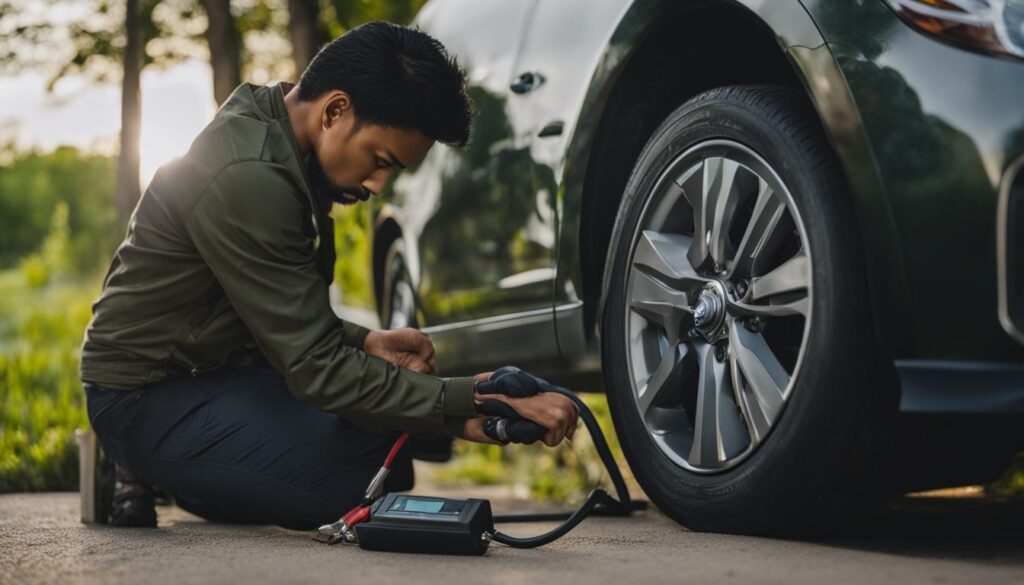
| Tire Pressure | Recommended Range |
|---|---|
| Car Tires | 30-35 psi |
| Light Trucks | 35-45 psi |
| Front Tires | 32 psi |
| Rear Tires | 30 psi |
| Spare Tire | Check recommended values |
Proper tire pressure is crucial for a safe and comfortable ride. Ensuring that your tires are correctly inflated will not only improve fuel efficiency but also enhance the overall performance of your vehicle. Don’t underestimate the importance of regularly checking your tire pressure and maintaining it within the recommended range.
Determining the Correct Tire Pressure
Knowing the correct tire pressure for your vehicle is essential to ensure optimal performance and safety on the road. The recommended tire pressure values may vary depending on the type of vehicle you drive. Generally, it is recommended to maintain a tire pressure of 30-35 psi for cars. Light trucks may require higher pressure, while some vehicles have different pressure values for front and rear tires. To find the recommended tire pressure for your vehicle, refer to your car’s manual or check the driver-side doorpost.
It is crucial to check the tire pressure in your spare tire as well. The spare tire may have a different pressure requirement, and neglecting it can lead to problems when you need it the most. Ensuring that your spare tire is properly inflated will give you peace of mind during emergencies or unexpected situations on the road.
Remember that maintaining the correct tire pressure is not only important for safety, but it also affects your vehicle’s fuel efficiency and overall performance. Underinflated tires can increase fuel consumption and cause poor traction, while overinflated tires can result in a harsh ride and uneven tire wear. By following the recommended tire pressure values, you can optimize your driving experience and prolong the lifespan of your tires.
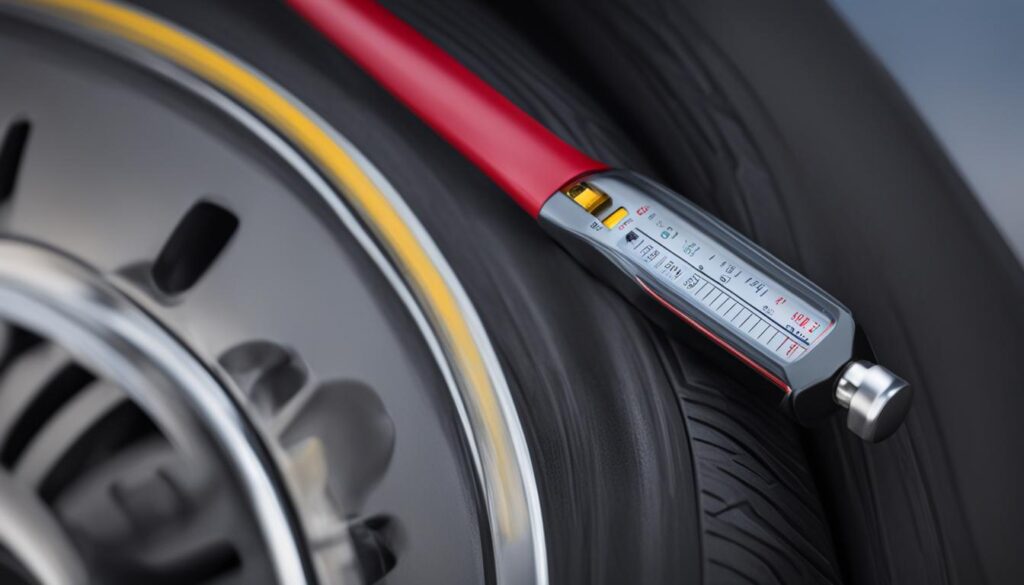
Table: Recommended Tire Pressure for Different Vehicles
| Vehicle Type | Recommended Tire Pressure (psi) |
|---|---|
| Car | 30-35 |
| Light Truck | 35-40 |
| SUV | 30-35 |
| Minivan | 30-35 |
| Motorcycle | 30-40 |
Refer to the table above for a general guideline of the recommended tire pressure values for different types of vehicles. However, it is essential to check your specific vehicle’s manual or the doorpost for accurate and detailed information. Remember to adjust the tire pressure if you are carrying heavy loads or towing, as these factors can affect the recommended values. Keeping your tire pressure within the recommended range will help ensure a safe and comfortable driving experience while maximizing the lifespan of your tires.
Choosing the Right Air Pump
When using a portable tire inflator, one of the key considerations is choosing the right air pump. The type of air pump you select will depend on your specific needs, budget, and convenience.
Automatic air compressors are a popular choice for their speed and ease of use. These pumps are electrically powered and can quickly inflate your tires to the desired pressure. They are more expensive than other options but offer convenience and efficiency.
On the other hand, manual floor pumps are a more cost-effective option. These pumps require physical effort to operate, as you manually pump air into the tires. While they may take longer to inflate the tires, they are reliable, durable, and do not rely on external power sources.
Additionally, if you don’t own a portable tire inflator, you can find air pumps at gas stations. Many gas stations provide coin-operated air pumps that you can use to inflate your tires. These pumps are convenient if you don’t want to invest in your own air pump or need to quickly top up your tire pressure on a road trip.
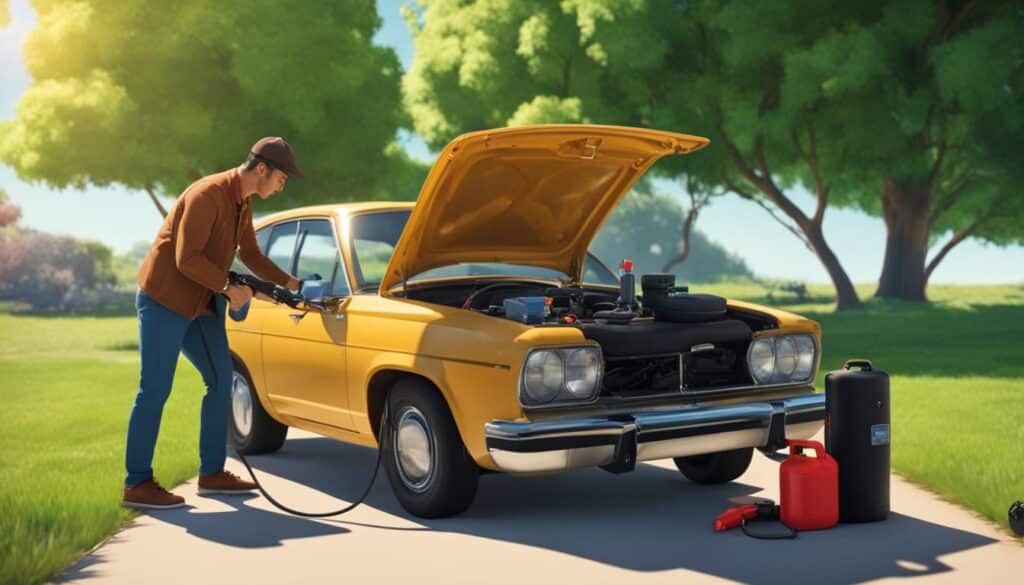
Comparison of Air Pump Options
| Option | Speed | Convenience | Cost |
|---|---|---|---|
| Automatic air compressor | Fast | Convenient | Higher |
| Manual floor pump | Slower | Reliable | Lower |
| Gas station air pump | Varies | Accessible | Coin-operated |
In summary, choosing the right air pump for your portable tire inflator is crucial for maintaining proper tire inflation. Consider factors such as speed, convenience, and cost when making your decision. Whether you opt for an automatic air compressor, a manual floor pump, or a gas station air pump, ensuring that you have a reliable and efficient way to inflate your tires will contribute to a safer and more enjoyable driving experience.
Inflating Your Tires at a Gas Station
When it comes to inflating your tires, a gas station is a convenient option. Not only do they provide easy access to air pumps, but they also have clear instructions and gauges to help you achieve the correct tire pressure. Follow these steps to ensure a successful tire inflation process using a gas station air pump.
Step 1: Prepare Your Vehicle
Before you begin, park your car close enough to the air pump so that the hose can reach all four tires. Make sure your vehicle is turned off, and remove the valve stem caps from each tire. This will allow for an easier connection to the pump and a more accurate pressure reading.
Step 2: Connect the Pump
Locate the air pump at the gas station and attach the hose to the valve stem of one tire. Ensure a secure connection by pressing the hose firmly onto the valve stem. Once connected, you can start the air pump by following the instructions on the pump itself.
“Pro Tip: Keep an eye on the pressure gauge throughout the inflation process. It will help you monitor the progress and prevent overinflation.”
Step 3: Inflate the Tires
As the air pump is running, you can begin inflating the tire. Keep an eye on the pressure gauge and fill the tire until you reach the recommended pressure level. Most gas stations display the recommended pressure values, making it easier for you to achieve the correct inflation.
Once the desired pressure is reached, remove the hose from the valve stem and move on to the next tire. Repeat the process for all four tires, ensuring they are all properly inflated.
| Tire | Recommended Pressure (psi) |
|---|---|
| Front Left | 32 |
| Front Right | 32 |
| Rear Left | 30 |
| Rear Right | 30 |
Once all tires are properly inflated, replace the valve stem caps and perform a visual inspection to ensure there are no signs of damage or abnormalities. Your tires are now ready for a safe and comfortable drive!
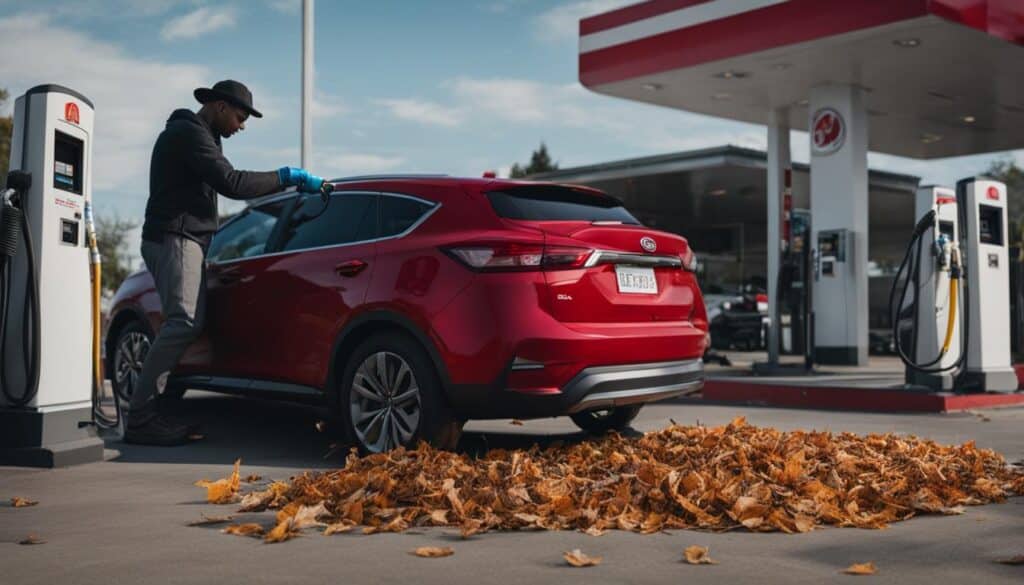
Inflating Your Tires With a Compressor
Using a compressor for tire inflation can be a convenient and efficient method to ensure your tires are properly inflated. Follow these simple steps to safely and effectively inflate your tires using a compressor:
- Start by ensuring that your tires are cold. It’s best to check the pressure and inflate them before driving or after they have cooled down for at least three hours.
- Remove the valve stem caps from each tire. These caps protect the valve and prevent dust and debris from entering.
- Connect the compressor nozzle to the valve stem securely. Make sure it is tightly attached to prevent any air leakage.
- Set the desired pressure level on the compressor. Refer to your vehicle’s manual or the recommended pressure values mentioned in section 5 for guidance.
- Turn on the compressor and allow it to inflate the tire. Keep an eye on the pressure gauge to monitor the progress. Avoid overinflating the tire by periodically checking the pressure and stopping the inflation process when the desired level is reached.
- Once the tire reaches the recommended pressure, turn off the compressor and disconnect the nozzle from the valve stem.
- Replace the valve stem caps to protect the valves from dust and debris.
Important Reminders:
- Always ensure your tires are cold before inflating them with a compressor, as the heat generated during driving can increase tire pressure.
- Regularly check your tire pressure to ensure it remains within the recommended range. Underinflated or overinflated tires can affect your vehicle’s handling and fuel efficiency.
- Properly maintaining and storing your compressor is essential for its longevity and performance. Follow the manufacturer’s instructions for maintenance and storage.
Using a compressor for tire inflation is a straightforward process that can be easily done at home. By following these steps and taking proper precautions, you can ensure your tires are properly inflated, promoting safety and optimal driving performance.
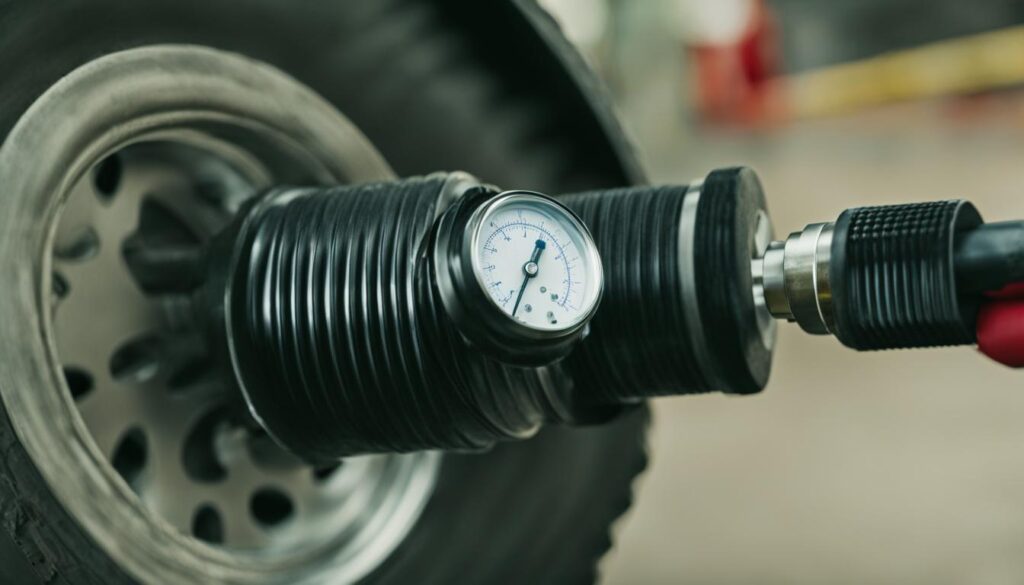
Tips for Proper Tire Inflation
Proper tire inflation is essential for optimal performance and safety on the road. Here are some valuable tips to help you maintain the correct tire pressure:
- Regularly check your tire pressure: Make it a habit to check the tire pressure at least once a month using a reliable tire pressure gauge. This will ensure that your tires are properly inflated and help you avoid potential issues.
- Follow the manufacturer’s recommendations: Refer to your vehicle’s manual or the driver-side doorpost for the recommended tire pressure values. Different vehicles may have different pressure requirements, so it’s important to follow the guidelines provided.
- Avoid overinflating or underinflating: Both overinflated and underinflated tires can lead to problems. Overinflated tires may result in a harsh ride and increased risk of a blowout, while underinflated tires can reduce fuel efficiency and negatively impact handling.
- Check tire pressure before long trips: Before embarking on a long journey, it’s crucial to check your tire pressure. Extended periods of driving can cause tires to heat up, potentially leading to increased pressure. Adjust the pressure accordingly to ensure safe and efficient travel.
- Inspect your spare tire: Don’t forget to regularly check the pressure of your spare tire as well. In the event of a flat tire, having a properly inflated spare tire can be a lifesaver.
- Consider temperature fluctuations: Tire pressure can fluctuate with changes in temperature. As the weather gets colder, tire pressure may drop. Keep this in mind and adjust the pressure as needed to maintain the correct levels.
By following these best practices for tire inflation, you can enhance the longevity of your tires, improve fuel efficiency, and ensure a safer driving experience. Remember, maintaining the correct tire pressure is a simple yet crucial aspect of vehicle maintenance that should not be overlooked.
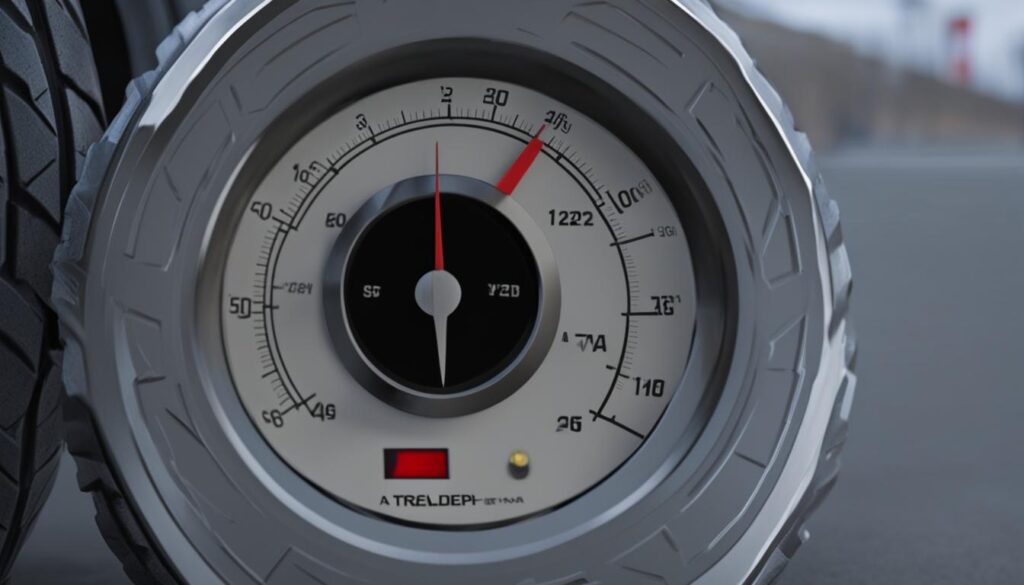
Maintaining Tire Pressure for Optimal Performance
Proper tire pressure maintenance is crucial for ensuring optimal tire performance and prolonging the lifespan of your tires. By regularly checking and maintaining the correct tire pressure, you can avoid potential issues such as increased fuel consumption, poor traction, and uneven tire wear. It’s essential to prioritize tire pressure as part of your regular vehicle maintenance routine.
One of the key reasons why maintaining the right tire pressure is important is fuel efficiency. Underinflated tires create more rolling resistance, which leads to increased fuel consumption. By keeping your tires properly inflated, you can improve your vehicle’s fuel efficiency and save money at the pump.
Additionally, maintaining the correct tire pressure contributes to better traction and handling. Overinflated tires have a smaller contact patch with the road, which can result in reduced grip and compromised handling. On the other hand, underinflated tires have a larger contact patch, leading to increased heat buildup and potential tire failure. By keeping your tires at the recommended pressure, you can ensure optimal traction and handling, enhancing both your safety and driving experience.
Table: Benefits of Proper Tire Pressure Maintenance
| Benefits | Explanation |
|---|---|
| Improved fuel efficiency | Proper tire pressure reduces rolling resistance, resulting in better fuel economy. |
| Enhanced traction | Correct tire pressure ensures optimal contact between the tires and the road, improving traction. |
| Increased tire lifespan | Maintaining the right tire pressure helps prevent uneven wear and extends the life of your tires. |
| Enhanced safety | Proper tire pressure improves handling and reduces the risk of blowouts and other tire-related accidents. |
Regularly checking and adjusting your tire pressure is a simple yet effective way to optimize tire performance. Make it a habit to use a reliable tire pressure gauge and check your tire pressure at least once a month, or before long trips. Remember to consult your vehicle’s manual or the driver-side doorpost for the recommended tire pressure values.
By prioritizing tire pressure maintenance, you can enjoy the benefits of improved fuel efficiency, better traction, increased tire lifespan, and overall safer driving. Don’t overlook this important aspect of vehicle maintenance, and make it a regular part of your routine to ensure optimal tire performance.
Importance of Tire Care and Maintenance
In addition to proper tire inflation, tire care and maintenance play a crucial role in ensuring the longevity and performance of your tires. Regular attention to tire care can help prevent accidents, improve fuel efficiency, and maximize your driving experience. By following a few simple practices, you can keep your tires in optimal condition and enjoy a safe and smooth ride.
Regular Tire Inspections
Regularly inspecting your tires is essential to identify any signs of wear, damage, or abnormalities. Look for cuts, bulges, or punctures on the tire surface, as well as any nails, screws, or other foreign objects embedded in the tread. Additionally, pay attention to the tread depth, ensuring it meets the recommended standards for safe driving. The depth should not be lower than 2/32 of an inch, as this can significantly reduce traction and increase the risk of hydroplaning. If you notice any issues during your inspection, it’s important to address them promptly by visiting a professional tire service center.
Proper Tire Rotation
Tire rotation is the process of moving tires from one position to another to ensure even tread wear and prolong their lifespan. Regularly rotating your tires can help maintain optimal traction, enhance overall performance, and extend the life of your tires. Most tire manufacturers recommend rotating tires every 6,000 to 8,000 miles, or as indicated in your vehicle’s owner’s manual. Consulting with a professional technician is advised to determine the appropriate rotation pattern for your specific vehicle and tire type.
| Tire Position | Recommended Rotation Pattern |
|---|---|
| Front-Wheel Drive | Front tires moved to rear and rear tires moved diagonally forward |
| Rear-Wheel Drive | Rear tires moved to front and front tires moved diagonally backward |
| All-Wheel Drive | Rotate all four tires diagonally |
Proper Wheel Alignment
Wheel alignment refers to the adjustment of the angles of the wheels to ensure they are parallel to each other and perpendicular to the ground. Proper wheel alignment is essential for optimal tire performance, even tread wear, and smooth handling. Misaligned wheels can cause uneven tire wear, decreased fuel efficiency, and compromised vehicle stability. Factors such as potholes, curb impacts, and general wear and tear can impact wheel alignment. It is recommended to have your wheel alignment checked regularly by a professional to maintain proper vehicle and tire performance.
By prioritizing tire care and maintenance, you can maximize the lifespan of your tires, improve fuel efficiency, and ensure a safer driving experience. Regular inspections, proper tire rotation, and wheel alignment are key practices to incorporate into your tire maintenance routine. Remember to consult your vehicle’s owner’s manual and seek professional assistance when necessary to address any tire-related concerns. With the right care and attention, you can enjoy the benefits of well-maintained tires for miles to come.
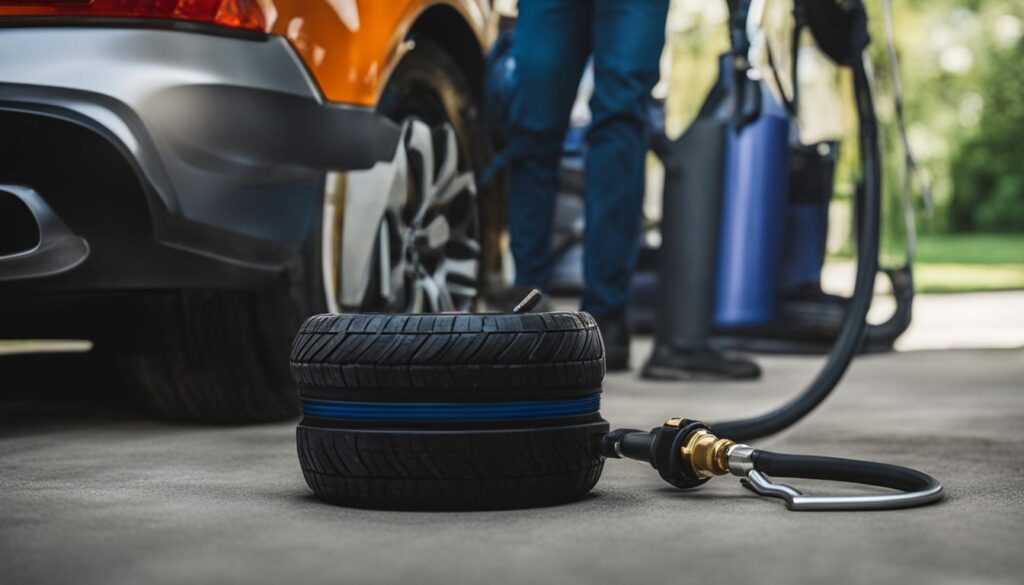
Conclusion
In conclusion, this comprehensive tire inflator guide provides you with the necessary knowledge and skills to confidently use a portable tire inflator. By following the step-by-step instructions and best practices outlined in this guide, you can ensure proper tire inflation and enjoy a safe and comfortable ride.
Remember, maintaining the correct tire pressure is crucial for optimal performance and safety. By regularly checking and adjusting your tire pressure, you can improve fuel efficiency, extend the lifespan of your tires, and enhance overall driving performance.
With the right tools and knowledge at your disposal, you can handle tire inflation emergencies on the road and stay prepared for any situation. So, take control of your tire care and maintenance today by mastering the basics of using a portable tire inflator. Safe travels!
FAQ
Why is proper tire inflation important?
Proper tire inflation is important for safety, fuel efficiency, tire wear, and overall driving experience. Underinflated or overinflated tires can lead to various issues, including decreased fuel efficiency, poor handling, uneven tire wear, and the risk of a blowout.
What type of tire pressure gauge should I use?
There are two types of tire pressure gauges to choose from: dial-type and pencil-type. Dial-type gauges have a graduated gauge and needle, while pencil-type gauges have a sliding extension forced out by air pressure. Consider your preference and budget when choosing a gauge, and make sure to buy one from a reputable auto-parts store.
How do I check the pressure in my tires?
To check the pressure in your tires, locate the valve stem on each wheel and unscrew the valve cap. Insert the open end of the tire pressure gauge onto the valve stem and hold it there firmly. The gauge will read the pressure, and you can check the reading on the small screen. It’s recommended to check your tire pressures monthly and adjust them accordingly.
What is the correct tire pressure for my vehicle?
The correct tire pressure varies depending on the type of vehicle you drive. Generally, maintaining a pressure of 30-35 psi for car tires is recommended, although light trucks may require higher pressure. Some vehicles have different pressure values for front and rear tires. Refer to your car’s manual or driver-side doorpost for the recommended tire pressures, and don’t forget to check the spare tire’s pressure as well.
What type of air pump should I use with my portable tire inflator?
When it comes to air pumps, you have options. Automatic air compressors are faster but more expensive, while manual floor pumps are slower but more cost-effective. You can purchase an air pump that plugs into your car’s 12v outlet or find a friend who owns one. Gas stations also provide coin-operated air pumps. Consider your needs and budget when choosing the right air pump for your portable tire inflator.
How do I inflate my tires at a gas station?
To inflate your tires at a gas station, start by removing the valve stem caps and locating the air pump. Make sure your tires are cold and position your car close enough for the pump hose to reach all four tires. Connect the pump hose to the valve stem and turn on the pump. Fill each tire until you achieve the recommended pressure, then replace the valve stem caps. Take a moment to inspect the tires before driving.
How do I inflate my tires with a compressor?
If you have a compressor, you can easily inflate your tires at home. Begin by ensuring your tires are cold and removing the valve stem caps. Connect the compressor nozzle to the valve stem and set the appropriate pressure level. Turn on the compressor and fill each tire until you reach the recommended pressure. Replace the valve stem caps and perform a visual inspection of the tires before driving.
What are some tips for proper tire inflation?
When it comes to proper tire inflation, it’s important to avoid overinflating or underinflating your tires. Regularly check the tire pressure, especially before long trips, and check the spare tire’s pressure twice a year. By following these tips, you can ensure that your tires are always properly inflated and ready for the road.
Why is maintaining tire pressure important for optimal performance?
Maintaining proper tire pressure is crucial for optimal performance. Underinflated tires can cause increased fuel consumption, poor traction, and premature wear. Overinflated tires can result in a harsh ride, reduced traction, and uneven tire wear. By regularly checking and maintaining the correct tire pressure, you can prolong the lifespan of your tires, improve fuel efficiency, and ensure a safer driving experience.
Why is tire care and maintenance important?
In addition to proper tire inflation, regular tire care and maintenance are essential. This includes rotating the tires regularly, checking for signs of wear and damage, and ensuring proper alignment. By taking care of your tires, you can extend their lifespan, improve fuel efficiency, and enhance overall driving performance.
